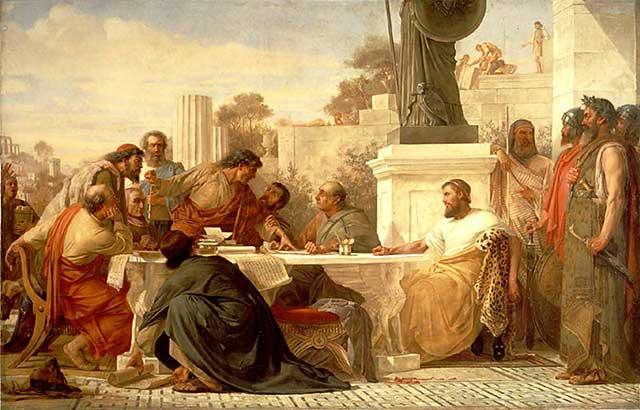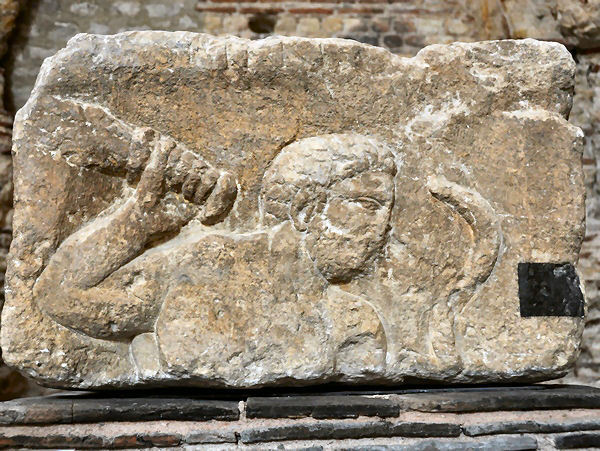Paris-Lutetia: From earliest times to c. 1000 (1):
Lutetia -- Paris as a Roman City
Colin Jones, Paris: Biography of a City (New York: Viking, 2005), pp.1, 11-12.
'Cara Lutetia'-'my beloved Lutetia'-wrote the Roman Emperor Julian of his stays in the city in AD 358 and then during the winter of 360-61,
is capital of the Parisii people. It is a small island lying in the river; a wall entirely surrounds it, and wooden bridges lead to it on both sides. The river seldom
Statue of the Roman God Mercury from Lutetia
rises and falls, but is usually the same depth in the winter as in the summer season, and it provides water which is very clear to the eye and very pleasant for one who wishes to drink. For since the inhabitants live on an island they have to draw their water chiefly from the river. The winter too is rather mild there, perhaps from the warmth of the ocean which is not more than 900 stades distant, and it may be that a slight breeze from the water is wafted thus far . . . A good kind of vine grows thereabouts and some individuals have even managed to make fig-trees grow by covering them in winter . . . to protect them from the cold wind.
This is the first description of any length that we have of the city which would become known as Paris. It is written with what was to become a familiar emotion in writings about Paris: affection. Its author was a man of power.
At this stage in its history, Paris was Lutetia. Julius Caesar, who conquered most of the current area of France in the first century BC, bringing it under Roman control, was the first to use the name 'Lutetia' (others said 'Lucotecia') to designate 'the city of the Parisii tribe'. . . .
One side of the "Boatman's Pillar" |
Despite the not unimpressive (if slow-coming) trappings of Romanitas, Lutetia was never more than a second-rung city throughout the period of Roman rule -- until Julian fleetingly associated it with imperial rule. The Romans allowed the existing tribal network to subsist throughout Gaul, and the Parisii had no primacy of any sort over the sixty-odd tribal groupings -- now renamed civitates ('city-states')-which made up 'Hairy Gaul'. Lutetia was merely the capital city of one civitas within the more extensive province of Gallia Belgica. It had little strategic importance. It was quite a distance, for example, from the limes, the fortified frontier which was erected to prevent incursions by Germanic tribal groupings across the Rhine and Danube and which guaranteed the pax romana throughout north-western Europe. Even when, in the fourth century, the tripartite division of Gaul was replaced by a system of smaller units, Lutetia failed to win administrative promotion: nearby Sens was made capital of the Fourth Lyonnais Division.
Lutetia was no more important socially, economically or culturally than It was administratively. With possibly up to 8,000 inhabitants, it contrasted with Narbonne and Nimes (in Gallia Narbonensis) as well as with Lyon, Autun, Reims and Trier, each of which had between 20,000 and 30,000 inhabitants (while Rome itself had three-quarters of a million). Lutetia's 50-odd hectares of site made a poor contrast with Reims's 600 hectares, Trier's 285 Autun's 200 -- or even with the pre-Roman Gaulish oppidum of Alesia (97 hectares). The fate of the coinage of the Parisii plus the fact that the Romanization of the built environment had taken time to get under way suggest that the city's economic fortunes were slow to recover from the trauma of conquest. Lutetia was one of relatively few Roman cities in northern Gaul in which building could be done in locally quarried stone: the deposits of limestone (for stone) and gypsum (for plaster) within a five-kilometre radius of the Ile de la Cite was to provide the raw materials of construction until modern times (the last limestone stone quarry closed in 1939) and over the centuries created vast, cavernous underground complexes. Most public buildings were only erected in the second and even third century AD. Stone, plaster and tile gradually supplanted wattle-and-daub and thatch-which never disappeared altogether. Though the building trades, pottery and metalwork all did respectably in the city's golden age, and led to the formation of manufacturing suburbs, Lutetia was not really a centre of production, and it specialized instead in the carrying trades. Here too the Parisian economy suffered from the imperial decision to build the main road linking provincial capital Lyon to England by way of Sens, Senlis and Beauvais, missing Paris out altogether.
The 'Boatmen's Pillar', an extraordinary archaeological find made in the environs of Notre-Dame cathedral in 1711, and dating from the beginning of the second century AD, suggests that, despite such problems, economic recovery was on its way. The stone pillar, some five metres high (viewable in Paris's Cluny Museum which also contains the vestiges of the Roman bath-house) represents the Roman gods (Mars, Venus, Mercury, Fortuna, Castor and Pollux, and Vulcan) happily consorting with Gaulish deities. It is inscribed (in pretty poor Latin): 'Under the reign of Tiberius Caesar Augustus, the boatmen (nautes) erected this monument to Jupiter, most great and most good, at their collective expense.' The pillar highlights the syncretic nature of Gallo-Roman religion, but also the social status and economic power of the boatmen whose organization, which predated the arrival of the Romans, seems to have powered the economic surge of the early second century AD.
Local produce was carried far afield. Beyond the three necropolises [cemeteries] on the city margins, large farms on the Roman model were to be found, worked by slave labour, giving Lutetia a garden city look. There was a big farm at Chaillot, for example, and another at Montmartre, which also contained temples dedicated to Mars and to Mercury. One had to go outside the bounds of the present-day boulevard peripherique encircling the city to find more densely inhabited locations (Clichy, Gentilly, Bobigny, lvry, Saint Denis).

Edward Armitage, Julian the Apostate Presiding at a Conference (1875)
